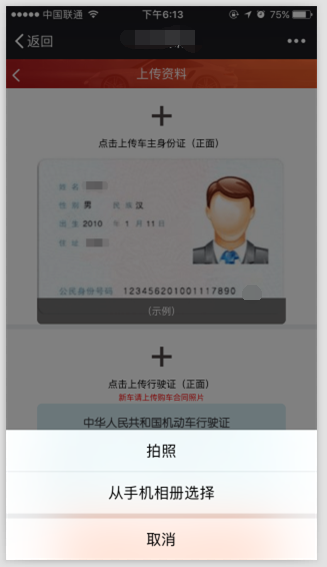wx.config({/* debug: true, */appId: appid, timestamp: timestamp, nonceStr: nonceStr, signature: signature,jsApiList: [ "chooseImage",//拍照或从手机相册中选图接口 "previewImage",//预览图片接口 "uploadImage",//上传图片接口 "downloadImage"//下载图片接口 ] });2.调起拍照/相册wx.chooseImage({count: 1, //张数, 默认9sizeType: ["compressed"], //建议压缩图sourceType: ["album", "camera"], // 来源是相册、相机success: function (res) { //var localIds = res.localIds; // 返回选定照片的本地ID列表,localId可以作为img标签的src属性显示图片 $(".driver-card img").prop("src",res.localIds[0]); uploadPhoto.uploadToWeixinServer(res.localIds[0],"car")}});这时我们可以看到这样的效果,代表调起成功了!chooseImage方法的成功回调里,我将选中的照片赋值给需要显示的img的src(因为我这里只有一张照片,如果有多张用循环赋值即可),这样一来,就可以直接显示刚刚拍照/相册里选中的照片了
3.上传照片
在上面chooseImage的success回调里面,可以看到我调用了uploadToWeixinServer方法,参数为本地照片的Id
uploadToWeixinServer: function(localId,type){wx.uploadImage({localId: localId,isShowProgressTips: 1, // 默认为1,显示进度提示success: function (res) { //res.serverId 返回图片的微信服务器端IDuploadPhoto.uploadToOwnerServer(res.serverId,type);//异步上传到我们自己的服务器}});},调用uploadImage接口后,将图片上传到了微信服务器,返回图片的ID,这个时候需要用ajax异步上传到自己的服务器里,调用微信提供的“获取临时素材”接口。当然也不一定是选择完照片就立即上传,还得根据实际业务需求出发,也有是静默上传(没有进度提示),也有是在最终提交表单时一起上传uploadToOwnerServer: function(serverId,type){$.ajax({data: {serverId:serverId,type:type},type : "POST",url : WX_ROOT + "wechat/uploadPhoto",success : function(json) {if (json) {var data = JSON.parse(json.data);if ("car" == type) uploadPhoto.options.carImage = data.path + data.nameelseuploadPhoto.options.idCardImage = data.path + data.name}}});},Controller@RequestMapping(value = "/uploadPhoto", method = RequestMethod.POST)public @ResponseBody HttpResult uploadPhoto(@RequestParam String serverId,@RequestParam String type) throws Exception{LOGGER.info("RestFul of uploadPhoto parameters serverId:{},type:{}",serverId,type);try {/** 将图片保存到本地服务器 **/String photoName = type + new Date().getTime() + UUID.randomUUID().toString();//文件路径不存在则创建File saveFile = new File(PIC_PATH + type);if (!saveFile.mkdir()) saveFile.mkdir();wechatService.saveImageToDisk(serverId, photoName, PIC_PATH + type + "/");LOGGER.info("Download the picture from weixin server pathL:{}",PIC_PATH + type + "/");JSONObject data = new JSONObject();data.put("name", type + "/" + photoName+".jpg");data.put("path", PIC_SERVER + "/");HttpResult rs = new HttpResult();rs.setCode(200);rs.setData(data.toJSONString());LOGGER.info("Download the picture from weixin server is successful!serverId:{},photoName:{}",serverId,photoName);LOGGER.info("HttpResult data:{}",rs.getData());return rs;} catch (Exception e) {LOGGER.error("Download the picture from weixin server is error",serverId);return null;}这里我使用了一个UUID生成主键规则,通过类型+时间戳+唯一字符串定义图片名称。如果上传成功,同时又将自己服务器的图片地址返回给前端。/** * 根据文件id下载文件* @param accessToken * @param mediaId* @return 文件流对象 */public InputStream getInputStream(String accessToken, String mediaId) { InputStream is = null; String url = "http://file.api.weixin.qq.com/cgi-bin/media/get?access_token="+ accessToken + "&media_id=" + mediaId; try { URL urlGet = new URL(url); HttpURLConnection http = (HttpURLConnection) urlGet.openConnection(); http.setRequestMethod("GET"); // 必须是get方式请求 http.setRequestProperty("Content-Type","application/x-www-form-urlencoded"); http.setDoOutput(true); http.setDoInput(true); System.setProperty("sun.net.client.defaultConnectTimeout", "30000");// 连接超时30秒 System.setProperty("sun.net.client.defaultReadTimeout", "30000"); // 读取超时30秒 http.connect(); // 获取文件转化为byte流 is = http.getInputStream(); } catch (Exception e) { LOGGER.error("Failed to convert inputStream from weixin server,accessToken:{},mediaId:{}",accessToken,mediaId);} return is;}servicepublic void saveImageToDisk(String mediaId, String picName, String picPath) throws Exception { String accessToken = getBaseAccessToken();InputStream inputStream = getInputStream(accessToken, mediaId); // 循环取出流中的数据byte[] data = new byte[1024]; int len = 0; FileOutputStream fileOutputStream = null; try { fileOutputStream = new FileOutputStream(picPath+picName+".jpg"); while ((len = inputStream.read(data)) != -1) { fileOutputStream.write(data, 0, len); } LOGGER.info("Write the fileInputStream is successful");} catch (IOException e) { LOGGER.error("Write the fileInputStream is error");} finally { if (inputStream != null) { try { inputStream.close(); } catch (IOException e) { LOGGER.error("Close the fileInputStream is error");} } if (fileOutputStream != null) { try { fileOutputStream.close(); } catch (IOException e) { LOGGER.error("Close the fileOutputStream is error");} } } } 4.总结